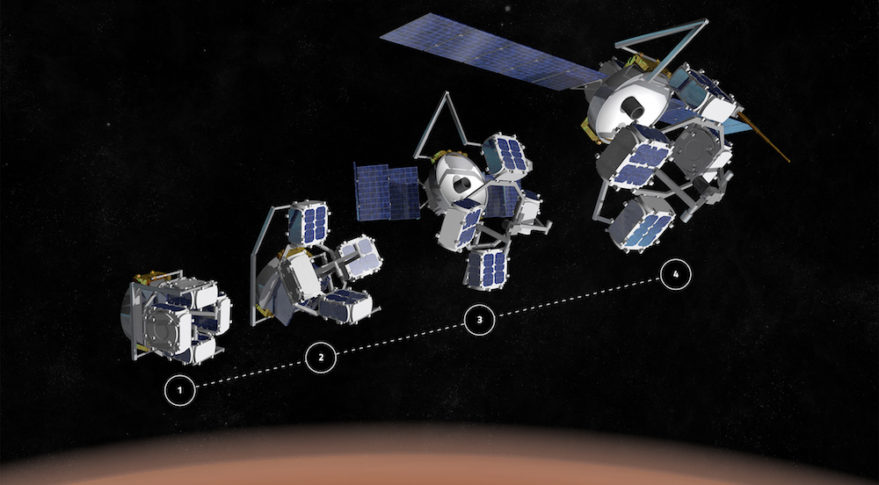Satlets: Crazy Idea or Ingenious Concept? This Week's Test on ISS Will Offer Clues

SAN FRANCISCO – On Oct. 25, astronauts onboard the International Space Station planned to link NovaWurks' spacecraft building blocks in the first on-orbit test of a radically new approach to satellite design and manufacturing.
Instead of fitting spacecraft components into a rectangular bus as companies have for decades, NovaWurks invented Hyper-Integrated Satlets (HISats), identical seven-kilogram modules with everything a satellite needs to function, including communications, pointing, power, data processing and propulsion. Satellite builders can mate any number of HISats, which measure 20 by 20 by 10 centimeters and snap together like Legos, to their payloads on Earth or in orbit. Software determines the role each HISat should play. If one HISat subsystem begins to fail, for example, the same subsystem on other HISats can help.
It's an approach Talbot Jaeger, founder and chief technologist of Los Alamitos, California-based Novawurks, came up with while contemplating the wonders of biological stem cells. "The architecture comes alive as it starts to grow, Jaeger told SpaceNews. "It creates an organism you can't defeat."
After years of development and ground testing plus two years of storage on ISS, NovaWurks engineers and their partners are waiting for the first on-orbit demonstration of their technology. If all went as planned, on Oct. 25 astronauts will assemble a small satellite by snapping together six HISats and two deployable solar arrays built by Pumpkin with an electro-optical imager in a NASA-sponsored mission called Satlet Initial Proofs and Lessons (SIMPL).
Then astronauts plan to launch the newly assembled small satellite from ISS on Oct. 27 using the NanoRacks Kaber Microsatellite Deployer, providing a key test of how well the HISats function as a single unit.
"Can they detect each other, recognize they've been put together and think as a group to get power and maintain altitude?" Jaeger asked.
Dave Barnhart, director of the University of Southern California's Space Technology and Systems Group, is eager to see. Like everyone who has been watching NovaWurks' efforts to transform the way satellites are built, Barnhart, who awarded NovaWurks a contract in 2012 to build HISats for the U.S. Defense Advanced Research Projects Agency's Phoenix program, which he managed, wants to see HISats work in space.
Get the Space.com Newsletter
Breaking space news, the latest updates on rocket launches, skywatching events and more!
"For 50 to 60 years, we've built satellites as monolithic entities," Barnhart said. "If we can now build something that is held together by cells that can actually function like a satellite, that's a huge deal."
Andrew Kalman, founder, president, CTO of cubesat manufacturer Pumpkin and a longtime NovaWurks partner, said engineers tend to devote a lot of time and effort to designing satellites that are slightly different. "Talbot is looking at it from the ground up and saying, 'If we could have something that could handle all these things with a minimum of further engineering, what would it look like?' He has made a very good case that his architecture is one way to do that," Kalman said.
The ISS experiment will provide the first evidence of how well HISats work in orbit, but additional tests are coming.
DARPA is "evaluating several launch options" to fly HISats to low Earth orbit in 2018, said Bill Crandall, NovaWurks advanced projects chief. As part of the Phoenix program aimed at demonstrating innovative, lower-cost satellite architectures, DARPA wants to launch 14 HISats linked with Raytheon's Space Enabled Effects for Military Engagements (SeeMe) imaging satellite as part of the eXperiment for Cellular Integration Technologies. The experiment is designed to show whether HISats remain linked when exposed to launch forces and, once in orbit, whether they can separate from SeeMe and adjust to the change by immediately reconfiguring their software.
Because NovaWurks sees HISats as all-purpose satellite tools, the company is eager to show that the modules can be assembled to form spacecraft of various shapes and sizes on the ground or in orbit. For example, a customer might want to assemble core elements of a spacecraft on the ground, launch it and then add HISats robotically.
"This will enable the dreamers to think differently about building the space stations, docks and vehicles for the moon, Mars and deep space," Jaeger said. "We can't keep doing it with fixed designs. We are trying to build the next generation of space tools."
Stanford, USC and NASA's Langley Research Center are among the first to test the tools NovaWurks is developing.
Langley researchers plan to measure the radiation exposure of airline crews and passengers with a sensor packaged called Rapid Response Radiation Survey.
"The conformal satellite platform allowed us to rapidly integrate a reasonably complex experiment," Nathanael Miller, a NASA Langley aerospace technologist and mission developer, said by email. It's "basically a plug and play system for satellites," Carrie Rhoades, NASA Langley SmallSat Lead, said by email.
NovaWurks shows payload developers how to link with the HISat common interface and gives developers its Applications Programming Interface. "They can take their payload and run it through all the tests with our satellite," Crandall said. "When they go to orbit they know it works."
This story was provided by SpaceNews, dedicated to covering all aspects of the space industry.
Join our Space Forums to keep talking space on the latest missions, night sky and more! And if you have a news tip, correction or comment, let us know at: community@space.com.
Debra Werner is a correspondent for SpaceNews based in San Francisco. She earned a bachelor’s degree in communications from the University of California, Berkeley, and a master’s degree in journalism from Northwestern University. Debra is a recipient of the 1989 Gerald Ford Prize for Distinguished Reporting on National Defense. Her SN Commercial Drive newsletter is sent out on Wednesdays.










